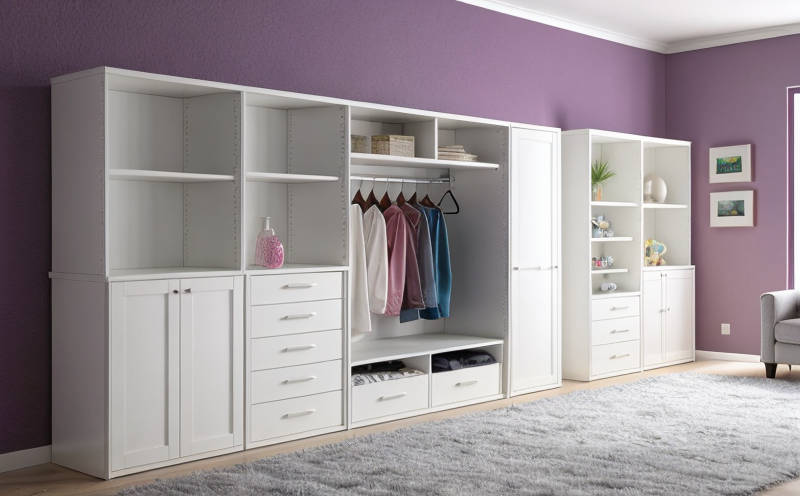ASTM D1037 Evaluating Properties of Wood Based Panels for Cabinets and Shelves
The ASTM D1037 standard is a critical tool in evaluating the physical properties of wood-based panels used in furniture, particularly those intended for use as cabinets and shelves. This test focuses on measuring the strength and stiffness under compression perpendicular to grain (parallel to the surface of the panel). The procedure is essential for quality managers, compliance officers, R&D engineers, and procurement personnel who ensure that materials meet industry standards.
The ASTM D1037 testing method involves preparing specimens from wood-based panels. These samples are then compressed in a universal testing machine (UTM) to determine their resistance under load. The test provides valuable data on the performance of these materials under real-world conditions, such as those encountered during assembly and use.
The process begins with selecting representative specimens cut from the panel material. Specimens must be conditioned to ensure they are at a standard moisture content before testing. This step is crucial because the moisture content can significantly affect the mechanical properties of wood-based panels. After conditioning, the specimens are placed in a UTM and subjected to increasing loads until failure.
The results from ASTM D1037 provide insights into how well the panel will perform under compression forces that occur during manufacturing and use. This information is vital for ensuring product durability and safety. The data can inform design decisions, material selection, and process improvements in furniture manufacturing.
Understanding the limitations of this test is also important. For instance, ASTM D1037 does not account for the effects of environmental conditions such as humidity or temperature changes that might occur after installation. However, it remains a fundamental tool for initial material evaluation.
The application of ASTM D1037 extends beyond just cabinets and shelves. It can be used in various contexts where wood-based panels are subjected to perpendicular compression forces. This includes applications like doors, drawer fronts, and other furniture components that require structural integrity.
| Standard | Description |
|---|---|
| ASTM D1037-20 | Procedure for Determining the Compressive Properties of Wood-Based Panels Perpendicular to Grain |
Why It Matters
The importance of ASTM D1037 cannot be overstated in ensuring the quality and safety of furniture products. Compliance with this standard is essential for manufacturers aiming to meet industry standards and consumer expectations. The test helps in identifying materials that are robust enough to withstand the stresses encountered during assembly and use.
From a compliance officer's perspective, ASTM D1037 ensures that products meet regulatory requirements, which can help avoid costly legal issues. For R&D engineers, this test provides critical data for material selection and process optimization. In procurement, it serves as a guide for selecting suppliers who deliver materials that consistently meet specified performance criteria.
The results of ASTM D1037 testing are also crucial for quality assurance teams. They can use these results to monitor the consistency of production batches and identify any deviations from expected performance early in the manufacturing process.
- Ensures compliance with industry standards
- Provides critical data for design decisions
- Supports material selection and process optimization
Applied Standards
The ASTM D1037 standard is widely recognized and used in the furniture manufacturing industry. It aligns with international standards that focus on wood-based materials, such as those from ISO (International Organization for Standardization) and EN (European Norm). These standards ensure a consistent approach to testing across different regions.
The ASTM D1037 procedure involves several key steps:
- Preparation of specimens
- Conditioning the specimens to standard moisture content
- Testing in a universal testing machine (UTM)
- Analyzing the results and reporting findings
The standard provides detailed guidelines for each step, ensuring that tests are conducted consistently. This consistency is critical for comparing test results across different laboratories and manufacturers.
| Standard | Description |
|---|---|
| ASTM D1037-20 | Procedure for Determining the Compressive Properties of Wood-Based Panels Perpendicular to Grain |
Why Choose This Test
- Comprehensive Evaluation: ASTM D1037 provides a comprehensive evaluation of wood-based panels, offering insights into their strength and stiffness under compression.
- Industry Recognized: The standard is widely recognized and used by manufacturers, ensuring consistency in testing across different regions.
- Data for Design: It offers valuable data that can be used to optimize designs and select the most suitable materials for specific applications.
The ASTM D1037 test ensures that furniture components are robust enough to withstand compression forces. This is particularly important in high-stress areas such as cabinets and shelves, where users frequently apply pressure during assembly or use.
For manufacturers, the test results can help identify materials with superior performance characteristics, which can lead to improved product quality and customer satisfaction. Additionally, compliance with this standard helps avoid potential legal issues related to non-compliance with industry standards.





